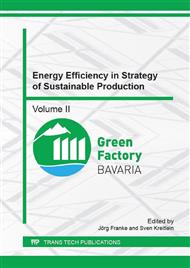p.166
p.174
p.181
p.188
p.195
p.201
p.209
p.217
p.224
Energy Efficient Strategies for Processing Rare Earth Permanent Magnets
Abstract:
Due to high magnetic fields causing strong interactions between permanent magnets and other ferromagnetic material, transport and handling of magnetized magnet bodies is challenging. To avoid undesired effects, such as influences on sensitive devices or difficult separation of the single magnets from stack, spacing and shielding of the magnet bodies is required leading to larger package sizes and thus in some cases higher energy demand during transport referred to the transported magnet mass. An optimization of the transport chain can be reached using the software tool presented in this paper. Further magnetizing high coercive rare earth magnets needs strong magnetic fields. To create the necessary field strength, copper coils are used requiring current strengths of several kA. Since the electrical resistance of copper differs from zero, this also means enormous thermal losses. Hence to reduce the losses and to avoid thermal damage of the coil, only short current pulses are applied generated by a pulse magnetizer. However, the efficiency of the process is very poor and lies in the lower per mil range. The presented paper explains the magnetization process in detail with focus on the losses within the magnetization device. Further different material parameters influencing the saturation field strength, such as conductivity, size and diameter to length ratio are presented and possibilities to improve the energy efficiency are shown.
Info:
Periodical:
Pages:
195-200
Citation:
Online since:
November 2016
Authors:
Keywords:
Price:
Сopyright:
© 2017 Trans Tech Publications Ltd. All Rights Reserved
Share:
Citation:


